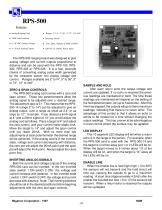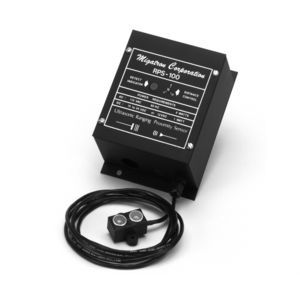
- Products
- Catalogs
- News & Trends
- Exhibitions
Proximity sensor controller RPS-300 seriesindustrial

Add to favorites
Compare this product
Characteristics
- Measured physical value
- proximity
- Applications
- industrial
Description
Various Sensing Ranges
Narrow Sensing Beam
High Frequency
LED Indicator
Sealed Transducer
RPS-500 Compatible
3-Way Power Operation
Isolated Form C Relay Output
Small Electronic Controller
Small Remote Transducer
The RPS-300 is a high frequency, sealed transducer unit best suited for environments where dirt and moisture are a problem. The transducer heads are made of Delrin with epoxy face for the 14″ and 36″ sensors and Valox with a silicon face for the 72″. The remote transducer allows for mounting of the sensor head in cramped spaces while the controller is out of the way. The ranging and proximity modes provide the versatility of simple detection, or actual distance measuring. The isolated form C relay furnishes N.O. and N.C. outputs, and with the addition of the RPS-500 card various analog outputs are supplied. The RPS-300 sensor operates at a frequency of 222kHz for the 14″ and 36″ ranges and 150kHz for the 72″ range. This sensor has a narrow sensing beam. Sensing ranges available for the RPS-300 include 4″ to 14″, 5″ to 36″, and 8″ to 72″. Mounting flanges, LED indicator, ranging potentiometer and 6-ft. transducer cable are included. Optional cable lengths are available.
Proximity Detection
Proximity detection is the detection of an object in a given range. The detection range of the RPS-300 is controlled by the “Range Control” potentiometer located on the front cover of the controller. Any object within the desired range is detected, while objects out of range are ignored. The detect point is independent of size, material, and reflectivity. The Proximity Option is denoted by the part number RPS-300-14.
Catalogs
Related Searches
- Proximity switch
- Cylindrical proximity switch
- IP67 proximity switch
- Distance sensor
- Threaded proximity switch
- Rectangular proximity switch
- DC proximity switch
- Analog distance sensor
- Stainless steel proximity switch
- 24 Vdc proximity switch
- Cylindrical distance sensor
- Ultrasonic distance sensor
- 12 Vdc proximity switch
- Plastic proximity switch
- Standard proximity switch
- 15VDC proximity switch
- Compact distance sensor
- ATEX proximity switch
- IECEx proximity switch
- AC proximity switch
*Prices are pre-tax. They exclude delivery charges and customs duties and do not include additional charges for installation or activation options. Prices are indicative only and may vary by country, with changes to the cost of raw materials and exchange rates.













